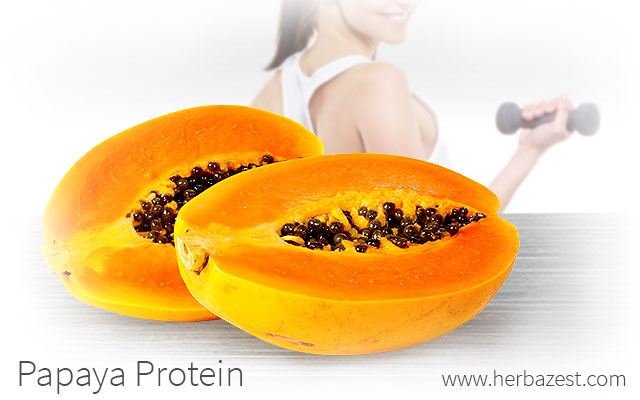Proteins in papaya are vital components of human nutrition, since they are essential for growing and repairing body tissue. Protein is an important element of papaya nutrition, added to a diverse list of vitamins and other phytocompounds in the fruit, all of which help regulate many important biological functions.
What Is Protein?
Used for building and maintaining solid muscles, strong bones, and healthy skin, proteins are essential nutrients present in every cell of the human body. They are derived from a variety of different foods and give the body the necessary energy to carry out its daily bioactivities. They also play a huge role in immunity: the body uses them to repair damaged tissues and ward off bacterial and viral infections.
Good sources of protein include meats, poultry, eggs, seafood, beans, nuts (particularly almonds), and seeds. Although the recommended intake varies according to age, sex, and physical activity, protein should generally account for about 10 - 15% of any well-balanced diet.
For most healthy individuals, the recommended daily intake of protein is about 0.8 grams per kilogram of body weight. One of the most challenging aspects of obtaining a sufficient intake of protein is remembering to limit the amount of foods that are high in saturated fats, as these can increase LDL cholesterol levels and the subsequent risk of heart attack, stroke, and other problems.
Protein in Papaya
Some research indicates that proteins from papaya and other low-fat, plant-based sources are associated with lower blood pressure and a decreased risk of cardiovascular disease.
Providing about 0.47 grams of protein per 100-gram serving, consumption of the low-fat papaya fruit can help to stabilize cholesterol levels, as well as helping to prevent the occurrence of several major illnesses in the process.
While similar fruits are richer in their protein content per 100 grams, such as guava (2.55 g), avocado (2.0 g), pomegranate (1.67 g), and kiwi (1.14 g), papaya has the lowest content of fat. In fact, a raw avocado of the same size contains more than four times as much protein and 50 times more fat than a papaya fruit, although it is the good type, monounsaturated.
A PAPAYA, KIWI, AND AVOCADO SMOOTHIE CAN PROVIDE A TASTY, EASY-TO-DIGEST PROTEIN PUNCH BETWEEN MEALS.
Although proteins in papaya are not as abundant as in other herbs, like peanut, quinoa, or sacha inchi, they contribute to the body's inexhaustible need for this important cellular-supportive nutrient, and are therefore comparable to apple, grapefruit, and pineapple. With many different modern culinary uses, papaya also tend to be much more gastronomically diverse than these other fruits, and can be used in an incredible variety of ways, from jams and preserves to smoothies, curries, and salads.
What is Papain?
Papain is the most notable compound in papaya. It is a protein-cleaving enzyme that facilitates chemical reactions in cells. Specifically, papain helps break down proteins into their essential components. For this reason, papain is thought to assist with the digestion of meat.
Combined with a diversified and varied nutritional diet, the proteins in papaya possess important health benefits and provide energy and support for the body's daily functions.
Sources
- American Hearth Association, Protein and heart health
- Frostburg State University, General Chemistry Online, Why is papain an effective meat tenderizer?
- Harvard University, Harvard Medical School, How much protein do you need every day?
- National Institutes of Health, National Institute on Aging, Protein, carbohydrates, & fats
- USDA Center for Nutrition Policy and Promotion, What is the relationship between vegetable protein and/or soy protein and selected health outcomes? | All about the protein foods group
- USDA Nutrient Database, Papayas, raw | Guavas, common, raw | Avocados, raw, all commercial varieties | Kiwifruit, green, raw | Pomegranates, raw | Apples, raw, with skin | Grapefruit, raw, pink and red and white, all areas | Pineapple, raw, all varieties




